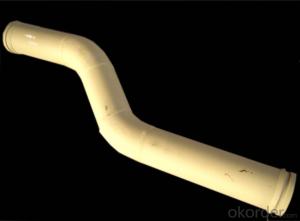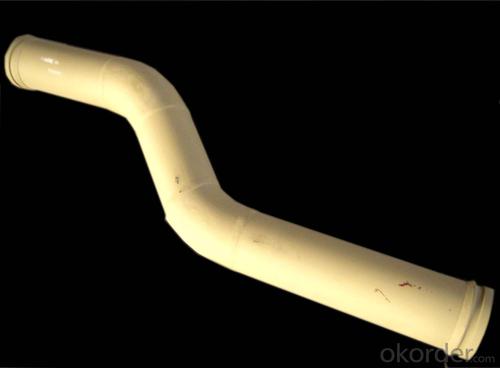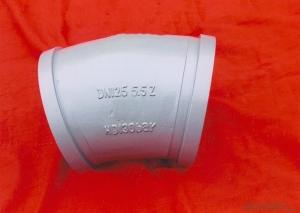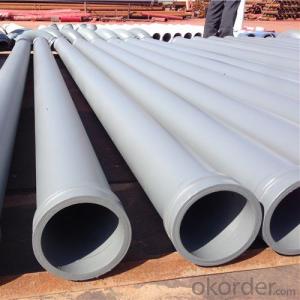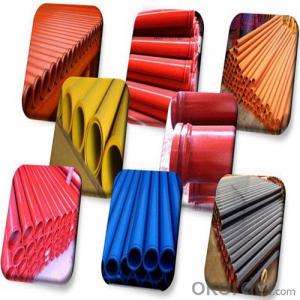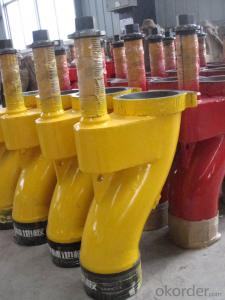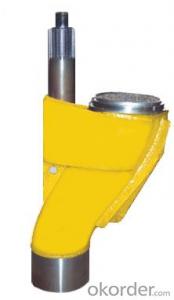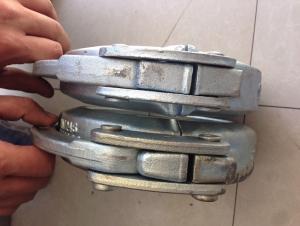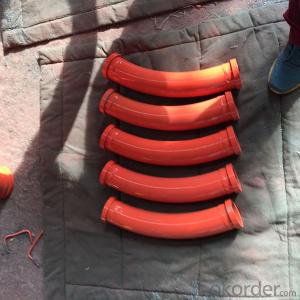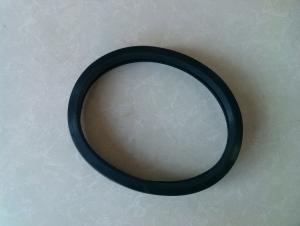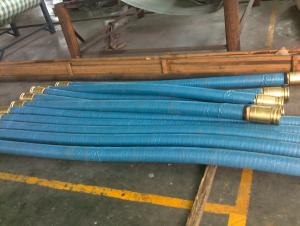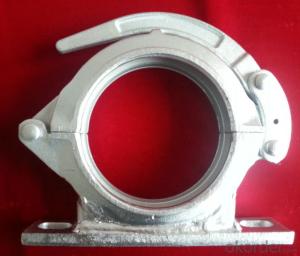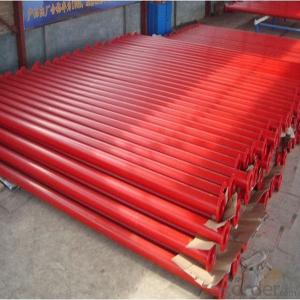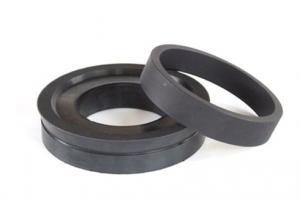PM S-TUBE 2*45degree for Putzmeister concrete Pump
- Loading Port:
- Tianjin
- Payment Terms:
- TT or LC
- Min Order Qty:
- 5 pc
- Supply Capability:
- 2000 pc/month
OKorder Service Pledge
OKorder Financial Service
You Might Also Like
Specifications
Concrete Pump Spare Part Elbow PM S-TUBE 2*45degree for Putzmeister concrete Pump
1.Length:1m-9m
2.Material:ST52,45Mn2,20#
3.Thickness:4mm-7mm
Concrete Pump Spare Part Elbow Pipe factory sales well in the world
1. Specification: DN125 , DN150
2. Service brand: PM, Schwing, Sany, Zoomlion...etc
3. Good material buy from state-owned company----Materical Certified
Concrete Pump Pipe | |||||||
Type | DN | WT (mm) | Length(s)(mm) | Companion Flange | (HRC) | Depth of hardness Layer (mm) | Application Life (CBM) |
Hardened | 125 | 4.5 | below 9 | 148(mm)Multiunit Flange | 60-65 | 2-2.5 | 20,000-30,000 |
Pipe | 4.85 | 148(mm)Multiunit Flange | 2-2.5 | 25,000-30,000 | |||
(45Mn2) | 5 | 148(mm)Multiunit Flange | 2.5-3 | 35,000-40,000 | |||
7 | 152-148(mm) Multiunit Flange | 3.0-4.0 | 40,000-50,000 | ||||
Common | 125 | 4.5 | below 9 | 148(mm)Multiunit Flange | 10 | 8,000 | |
Pipe | 4.85 | 148(mm )Multiunit Flange | 1,000 | ||||
(45Mn2) | 5 | 148(mm ) Multiunit Flange | 12,000 | ||||
7 | 152-148(mm) Multiunit Flange | 20,000 | |||||
Double | 125 | 2.5+2 | below 9 | 148(mm)Multiunit Flange | 60-65 | 2.5 | 40,000 |
Layer | 3+2 | 148(mm)Multiunit Flange | 3 | 50,000 | |||
Pipe (45Mn2) | 4+3 | 152-148(mm) Multiunit Flange | 4.5 | 70,000 | |||
Common | 125 | 4 | below 9 | 148(mm)Multiunit Flange | 60-65 | ||
Steel | 4.5 | 148(mm)Multiunit Flange | |||||
Pipe (20#) | 4.75 | 148(mm)Multiunit Flange | |||||
150 | 4.5 | 148(mm)Multiunit Flange | |||||
5 | 148(mm) Multiunit Flange | ||||||
Different kinds of concrete pump pipes
TYPE 1 Products:Welded Concrete Pump Pipe Size:DN125*133mm*4.5mm*3000mm DN125*133mm*4.0mm*3000mm Material:20# steel Using life (CBM):8000-15000 Highlights:Fit for Trailer-mounted pump only,Very Low TYPE 2 Products:ST52 Concrete Pump pipe Size:DN125 *133mm*4.5mm*3000mm DN125 *140mm*7.1mm*3000mm Material:ST52 Using life (CBM):15000-20000cubic meter Highlights:Real seamless and lower price TYPE 3 Products:Hardened Concrete Pump Pipe Size:DN125*133mm*4.5mm*3000mm DN125*140mm*7.1mm*3000mm Material:45Mn2 Using life (CBM):more than 30000 cubic meter Highlights:High wear resistance, very long life TYPE 4 Products:Twin wall Concrete Pump Pipe Size:DN125*133mm*4.5mm*3000mm (2mm+2.5mm) Material:Twin wall Using life (CBM):50000-60000 cubic meter Highlights:Two layers, the longest life-span
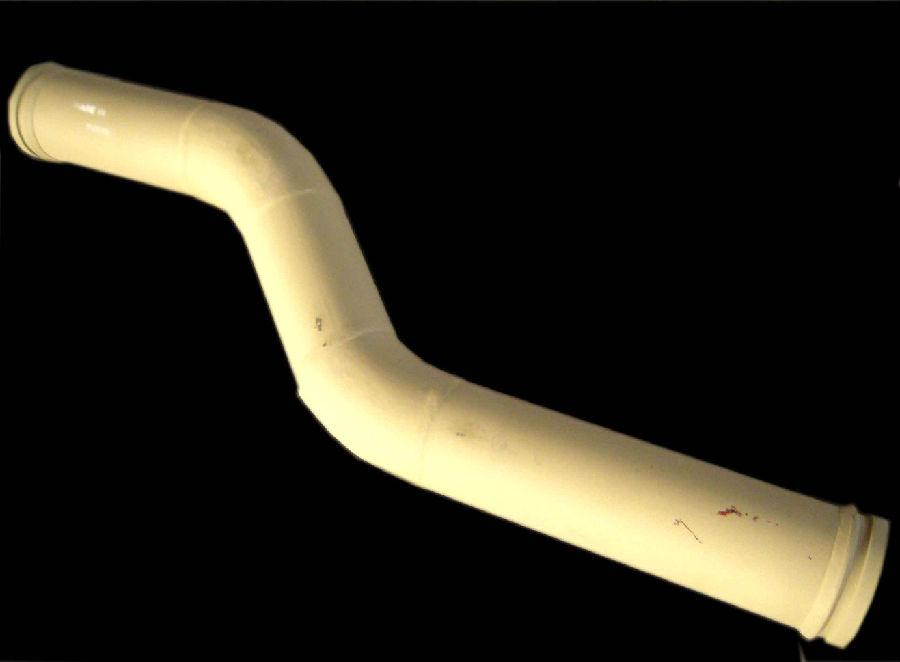
- Q: What are the different types of concrete pump hopper pins?
- There are several types of concrete pump hopper pins, including snap pins, lynch pins, and clevis pins. These pins are used to secure the hopper to the pump and ensure it stays in place during operation.
- Q: Are there any cost-effective alternatives to original concrete pump spare parts?
- Yes, there are cost-effective alternatives to original concrete pump spare parts. One option is to consider purchasing aftermarket parts, which are often produced by third-party manufacturers. These parts are designed to meet the same specifications and standards as the original parts but are typically available at a lower price. Another option is to explore the option of purchasing used or refurbished parts. These parts have been previously used but have been restored to a good working condition, offering a more affordable alternative to new parts. However, it is important to ensure that these alternatives are sourced from reputable suppliers to ensure quality and compatibility with your specific concrete pump model.
- Q: What are the consequences of using substandard concrete pump spare parts?
- There are several consequences to using substandard concrete pump spare parts. Firstly, these parts may not fit properly or be of the same quality as the original ones, which can lead to a decrease in the overall performance and efficiency of the pump. This can result in the pump being unable to deliver the necessary amount of concrete or experiencing frequent breakdowns, causing project delays and higher costs. Secondly, substandard parts may have a shorter lifespan compared to genuine parts. This means that they may wear out or break down sooner, requiring more frequent replacements. This not only increases maintenance costs but also raises the risk of unexpected equipment failures during operation, which can be hazardous for workers and potentially cause accidents. Moreover, the use of substandard parts can compromise the safety of the concrete pump. Genuine parts are designed and manufactured to meet strict quality standards and ensure proper equipment functioning. In contrast, substandard parts may not undergo the same rigorous testing and quality control measures, making them less reliable and more prone to failure. This poses a serious risk to operators and other personnel working near the concrete pump. Additionally, the use of substandard parts can void any warranties or guarantees provided by the manufacturer. Manufacturers typically offer warranties on their products to ensure customer satisfaction and provide support in case of any issues. However, if substandard parts are used, the manufacturer may refuse to honor the warranty, leaving the owner responsible for any necessary repairs or replacements. To summarize, the use of substandard concrete pump spare parts can lead to reduced performance, increased maintenance costs, greater accident risks, and voided warranties. It is crucial to always use genuine parts specifically designed for the concrete pump to ensure optimal performance, longevity, and safety.
- Q: What is the difference between concrete pump and ground pump?
- Ground pump only conveying function, the price is cheaper, and now are used to transport mixing machine, the ground pump is a bit uneconomical
- Q: How often should concrete pump accumulators be inspected and replaced?
- To ensure proper functioning and prevent potential issues, it is important to regularly inspect concrete pump accumulators. The frequency of inspections will depend on factors such as manufacturer recommendations, usage intensity, and operating conditions. As a general rule, it is recommended to inspect the accumulators at least every six months or after every 500 hours of operation, whichever comes first. However, if the pump is used more frequently or operates under harsh conditions, more frequent inspections may be necessary. During the inspection, check the accumulators for visible signs of wear or damage, such as leaks, cracks, or corrosion. Additionally, test the pressure levels and performance to ensure they meet the required standards. When it is time for replacement, it is best to follow the manufacturer's recommendations. Typically, accumulators have a lifespan of around 3 to 5 years, but this can vary based on maintenance, usage, and environmental conditions. If any significant issues are found during the inspection or if the accumulators have reached their recommended lifespan, it is advisable to promptly replace them to avoid potential failures and ensure the safety and efficiency of the concrete pump.
- Q: Can I get spare parts for both concrete pumps with and without boom control systems?
- Yes, you can get spare parts for both concrete pumps with and without boom control systems.
- Q: How often should concrete pump remote control antennas be inspected and replaced?
- To ensure optimal functionality, it is necessary to regularly inspect the antennas of the concrete pump remote control. The frequency of these inspections will vary depending on the usage and working conditions of the pump. In general, it is advisable to conduct inspections at least once a year or after every 500 hours of usage, whichever occurs first. However, if the pump is subjected to harsh environments or experiences frequent wear and tear, more frequent inspections may be required. It is crucial to carefully examine the antennas for any indications of damage, such as cracks, corrosion, or loose connections. If any damage is detected, immediate replacement of the antenna is essential to prevent disruptions in the remote control signal. By conducting regular inspections and promptly replacing antennas when necessary, the concrete pump can operate smoothly and efficiently.
- Q: How long do concrete pump rubber hoses typically last?
- Concrete pump rubber hoses typically last around 1 to 5 years, depending on various factors such as usage, maintenance, and environmental conditions.
- Q: In general, how much concrete will be transported per hour for the concrete pump and the pump?
- Tank car replacement, reversing the car by about 5-8 minutes
- Q: How often should hopper vibrators be inspected or replaced in a concrete pump?
- To ensure the proper functioning of hopper vibrators in a concrete pump and prevent any potential problems, it is important to conduct regular inspections. The frequency of these inspections or replacements may vary depending on several factors, such as the intensity of use, operating conditions, and the manufacturer's recommendations. As a general rule, it is recommended to inspect hopper vibrators at least once a year or after every 500-600 hours of operation, whichever comes first. However, if the concrete pump is heavily used or operates in harsh environments, more frequent inspections may be necessary. During the inspection, it is essential to check the hopper vibrators for any signs of wear, damage, or loose connections. Additionally, the vibration intensity and frequency should be assessed to ensure they are within the recommended range. Any issues identified during the inspection should be promptly addressed through repairs or replacements to ensure the hopper vibrators continue to function effectively. Regular inspections and timely replacements of hopper vibrators are crucial for maintaining the efficiency and reliability of a concrete pump. Neglecting these inspections can result in decreased performance, increased downtime, and potentially expensive repairs. Therefore, it is important to adhere to the manufacturer's guidelines and seek professional advice to determine the appropriate frequency for inspections and replacements based on the specific circumstances of your concrete pump.
Send your message to us
PM S-TUBE 2*45degree for Putzmeister concrete Pump
- Loading Port:
- Tianjin
- Payment Terms:
- TT or LC
- Min Order Qty:
- 5 pc
- Supply Capability:
- 2000 pc/month
OKorder Service Pledge
OKorder Financial Service
Similar products
Hot products
Hot Searches
Related keywords
